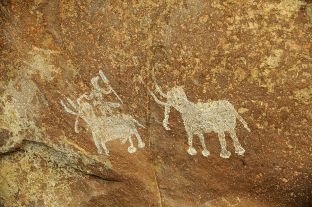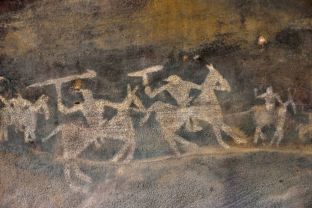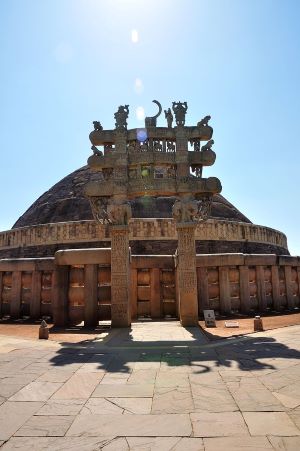
Bhimbetka in Madhya Pradesh stands tall with the grandeur of seven hills and over 750 rock shelters with cave paintings of ancient times, distributed over 10 km.

It is a UNESCO World Heritage Site near Bhopal, renowned for its rock shelters and cave paintings. Bhimbetka has the oldest-known rock art in India, as well as it is one of the largest prehistoric complexes.
The place name Bhimbetka originated from a myth related to Bhima of Mahabharatha . Bhimbetka means “Bhima’s resting place” or “Bhima’s lounge”.
This amazing rock shelter consists of seven hills: Vinayaka, Bhonrawali, Bhimbetka, Lakha Juar (east and west), Jhondra and Muni Babaki Pahari
South of these rock shelters are successive ranges of the Satpura hills. It is within the Ratapani Wildlife Sanctuary, embedded in sandstone rocks, in the foothills of the Vindhya Range.
The Auditorium rock is the largest shelter at Bhimbetka. According to the accounts of Robert G. Bednarik this prehistoric cave has “cathedral-like” ambience with its Gothic arches and soaring spaces.
There is an ancient Mata Vaishavi Temple in Bhimbetka.
Location
Bhimbetka rock shelter is situated at Bhojpur Raisen in Bhopal District about 45 kilometres south-east of Bhopal, at the southern edge of the Vindhya Range.
Historical significance
Bhimbetka is a scenic and picturesque site with it is world famous rock shelters which throw light into the earliest traces of human life in India and evidence of the Stone Age starting at the site in Acheulean times.
Some of the Bhimbetka rock shelters feature prehistoric cave paintings and the earliest are dated to 10,000 BCE, corresponding to the Indian Mesolithic.
These cave paintings depict various types of animals and human figures with early evidence of community living with dance and hunting from the Stone Age. The paintings also depict warriors on horseback from a later time.
Link with Mythology
Indigenous people of Bhimbetka believes that Bhima during his exile used to rest here to interact with the locals. There is also a narrative that Bhima Worshiped Mata Vaishavi at this location and blessed for concurring the forthcoming war.
Auditorium cave.
The cave is one of the prominent features of Bhimbetka which throws light into the history of this place. It is surrounded by quartzite towers.
The cave’s plan is similar to a “right-angled cross” with four of its branches aligned to the four cardinal directions. The main entrance points to the east. At the end of this eastern passage, at the cave’s entrance, is a boulder with a near-vertical panel that is distinctive, one visible from distance and all directions – Chief’s Rock” or “King’s Rock]. The boulder with the Auditorium cave is the central feature of the Bhimbetka.
Cave paintings of Bhimbetka unravel the evolution of a civilization

The rock shelters and caves of Bhimbetka have a large number of paintings. Some of the oldest paintings are dated to 10,000 BCE.
It was W. Kincaid, a British India era official who first mentioned Bhimbetka in a scholarly paper in 1888.But the archeological significance of this rock caves was found by V. S. Wakankar. However, the prehistoric significance of Bhimbetka was revealed only in the 1970s.
There was human settlement here from the Stone Age through the late Acheulian to the late Mesolithic until the 2nd century BCE. The artefacts from the excavation site and the pigments present in deposits, as well as the rock paintings points to that.
The drawings and paintings of Bhimbetka can be classified under seven different periods.
V. S. Wakankar classified the drawings and paintings into seven different periods and dated the earliest paintings to have belonged to the upper Palaeolithic to be as early as 40,000 years ago
The colours used are vegetable colours which have endured through time because the drawings were generally made deep inside a niche or on inner walls.
Period I – (Upper Paleolithic): These are linear representations in green and include humans dancing and hunting.
Period II – (Mesolithic): small figures in this group show linear decorations on the body. There is animal as well as human figures and hunting scenes with the weapons such as barbed spears, pointed sticks, bows and arrows. The types of weapons used are clear indicators to the periods of history.
Tribal wars also have been portrayed here. The depiction of communal dances, birds, musical instruments, mothers and children, pregnant women, men carrying dead animals, drinking and burials are detected among the paintings.
Period III – (Chalcolithic) – These resemble paintings of the Mesolithic. These paintings denote that during this period the cave dwellers of this area were in contact with the agricultural communities of the Malwa plains, exchanging goods with them.
Period IV & V – (Early historic): The figures of this group have a schematic and decorative style and are painted mainly in red, white and yellow colors.
The association is of riders, depiction of religious symbols, tunic-like dresses and the existence of scripts of different periods.
The figures of yakshas, tree gods and magical sky chariots also have been found here.
Period VI & VII – (Medieval): These paintings are geometric linear and more schematic, however they show degeneration and crudeness in their artistic style. The colors used in these paintings seems to be prepared by combining black manganese oxides, red hematite and charcoal.
In one of the desolate rock shelters, the painting of a man holding a trident-like object and dancing has been found and it is assumed by many as Lord Shiva.

Many paintings of Bhimbetka has been lost or degenerated overtime.
It has been estimated that paintings of at least 100 rock shelters might have eroded away.
Bhimbetka stands with its numerous rock shelters in the lush green valley of Vindya ranges, since many centuries unravelling the history of mankind. It offers new lessons for exploring our roots taking a stroll through the depth of the caves which unfolds the untold history of people who thrived here centuries and decades ago.
How to reach Bhimbetka?
By air : Raja Bhoj Airport is the major airport of Bhopal, located around 15 km from the city center in Bairagarh suburban area on National Highway 12. Bhopal is well connected to the metros other cities by various companies’ airlines.
To reach Bhimbetka Rock Shelters from Bhopal, you can take a bus or taxi on NH46, which is about a 46 km drive.
By rail: The nearest railway station to the Bhimbetka Rock Shelters is Bhopal Junction (BPL]. It is served by the West Central Railways. Bhopal is on one of the two main Delhi to Mumbai railway lines and also on the main line to the southern state capitals of Chennai, Hyderabad, Bangalore and Thiruvananthpuram.
By road:
The nearest bus stand to the Bhimbetka Rock Shelters is Obaidullaganj, which is about 9 km away, and buses from Bhopal can take you there.
References
- https://www.britannica.com/place/Bhimbetka-rock-shelters
- https://www.mptourism.com/destination-bhimbetka.php
- https://www.incredibleindia.gov.in/en/madhya-pradesh/bhopal/bhimbetka-rock-shelters
- https://en.wikipedia.org/wiki/Bhimbetka_rock_shelters
- https://www.indiaculture.gov.in/rock-shelters-bhimbetka
- image courtesy-getty
